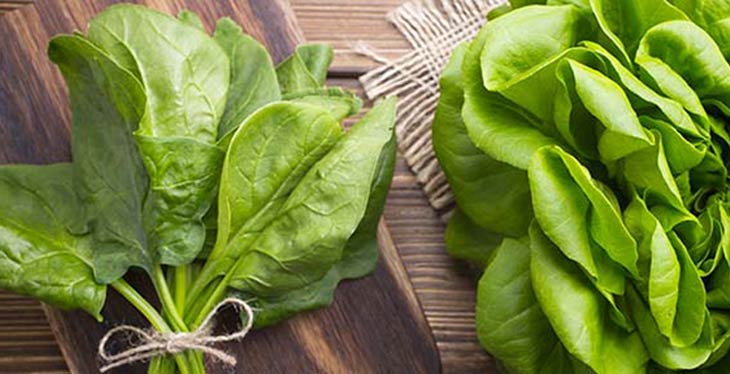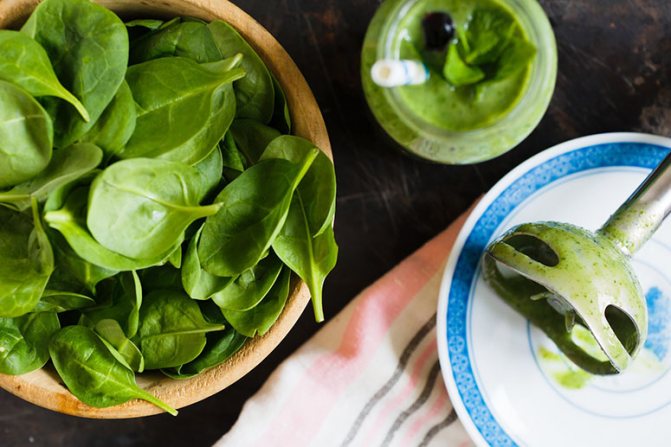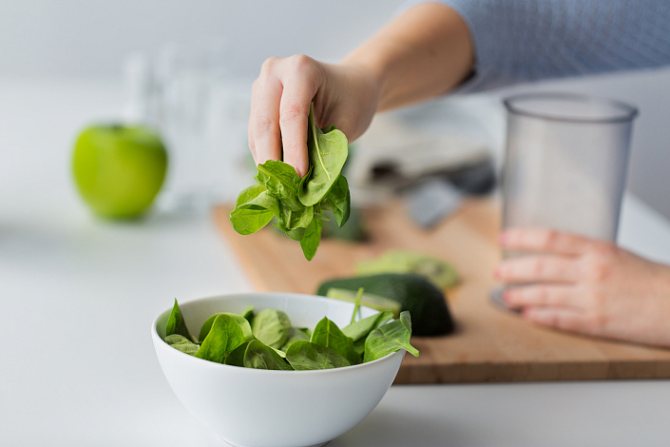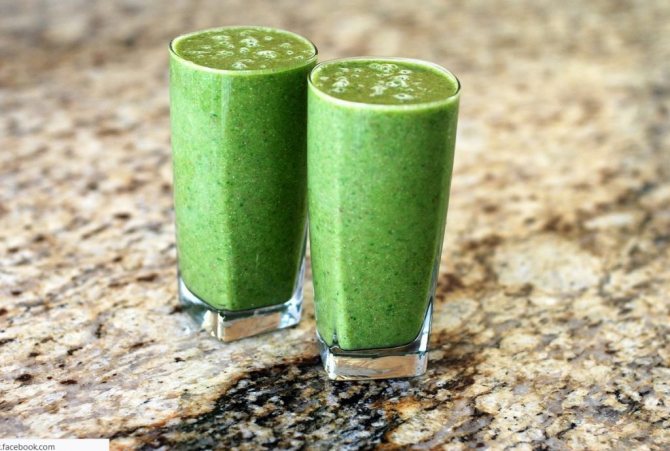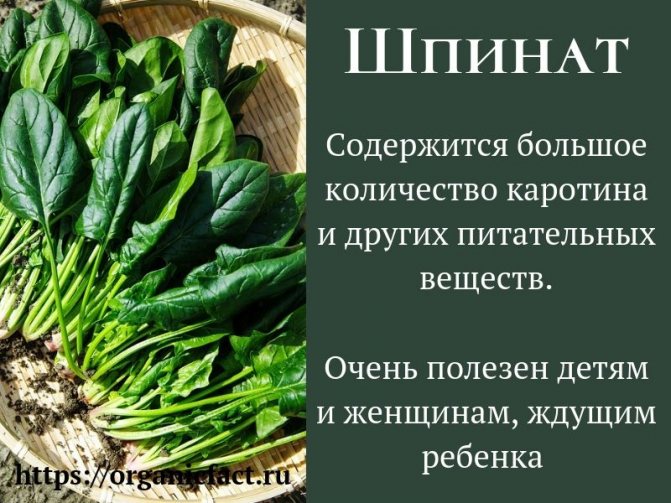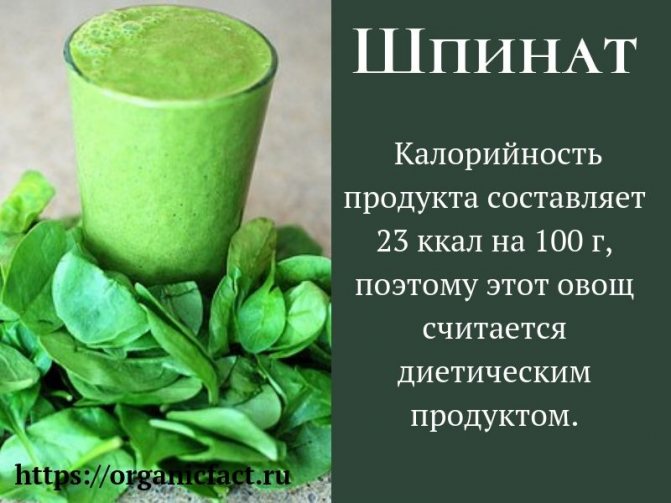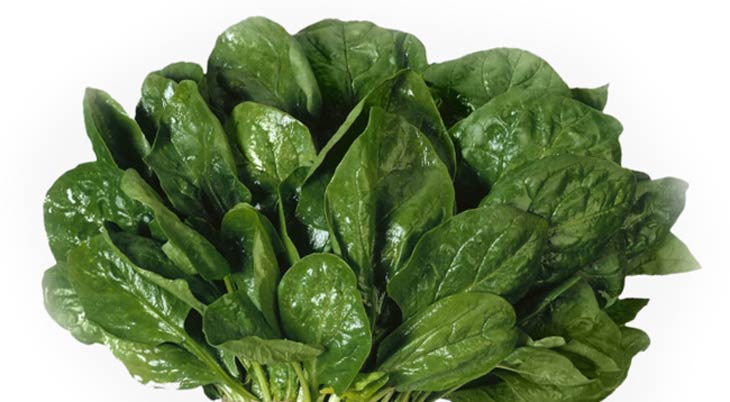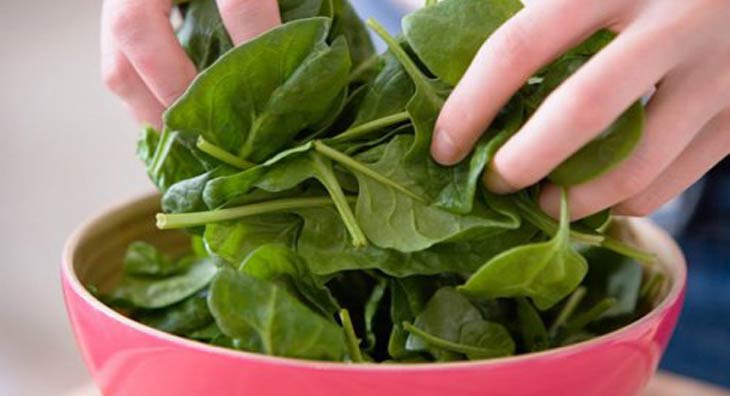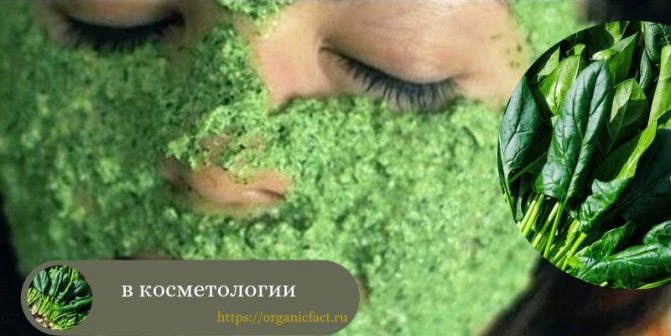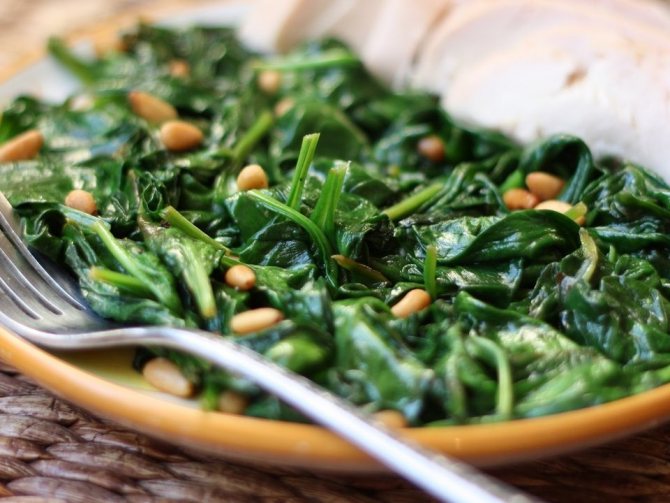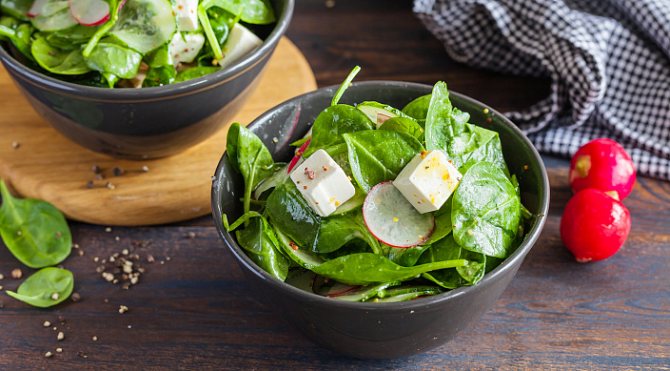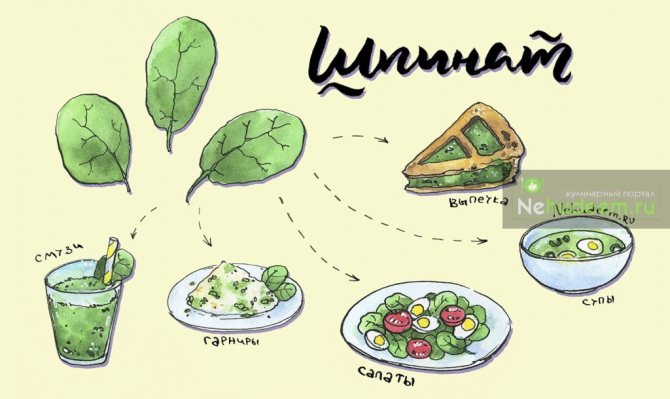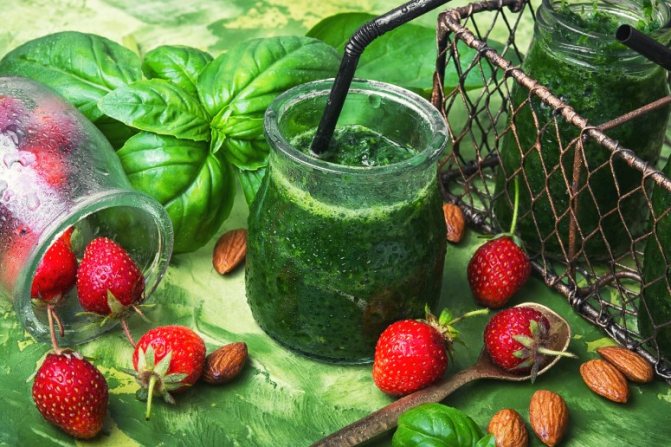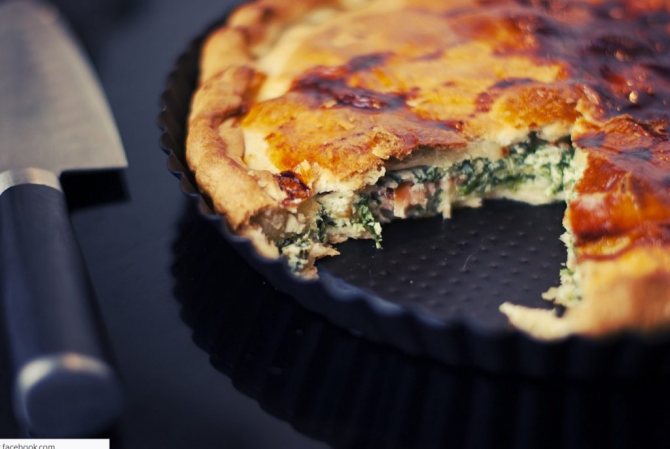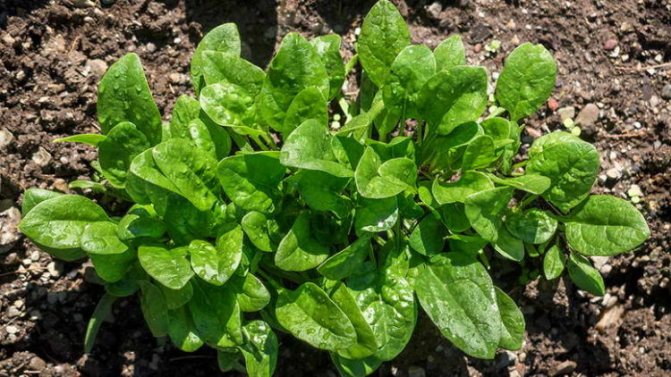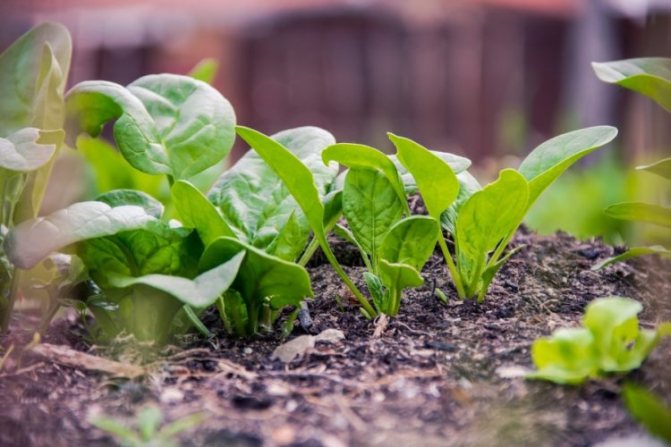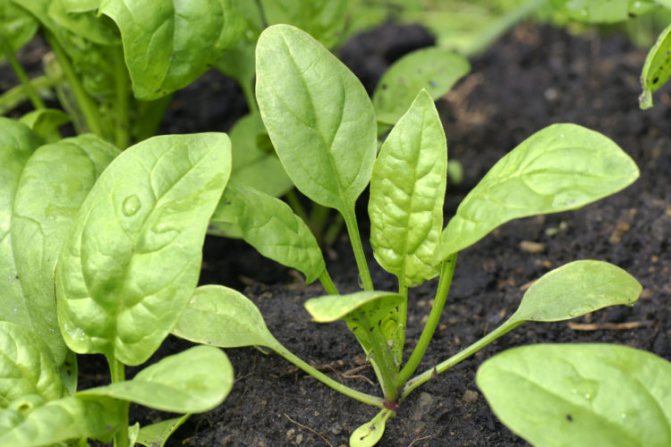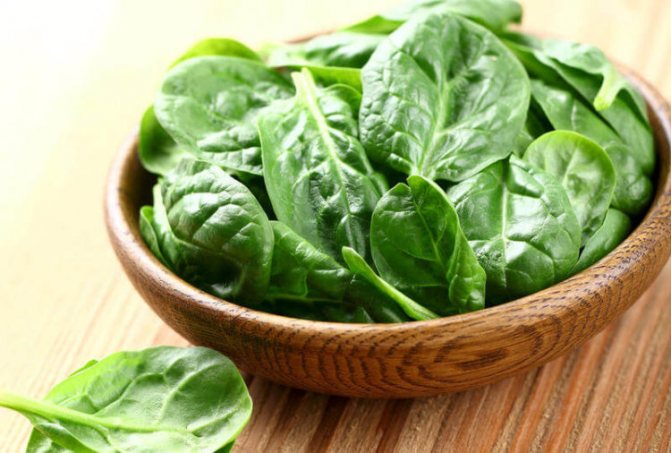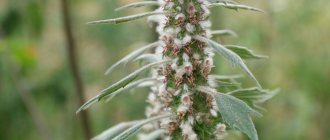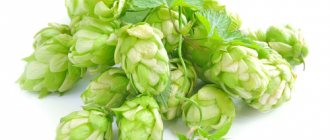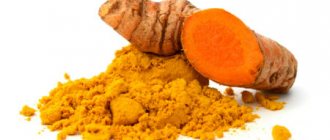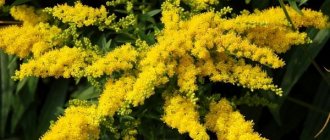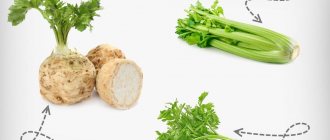Spinach is a herbaceous plant whose leaves are widely used in modern cooking! Once upon a time this product was better known to us from foreign films and cartoons. And the thing is that spinach gained popularity in European countries much earlier than in our country. Today, juicy spinach leaves can be easily found in any supermarket. With pleasure, this herbaceous gift of nature itself is grown by amateur gardeners in their beds and in greenhouses. Why is spinach so popular today? The benefits of this product exceed all expectations! Let's take a closer look at the benefits and risks of eating spinach.
Biological description and distribution
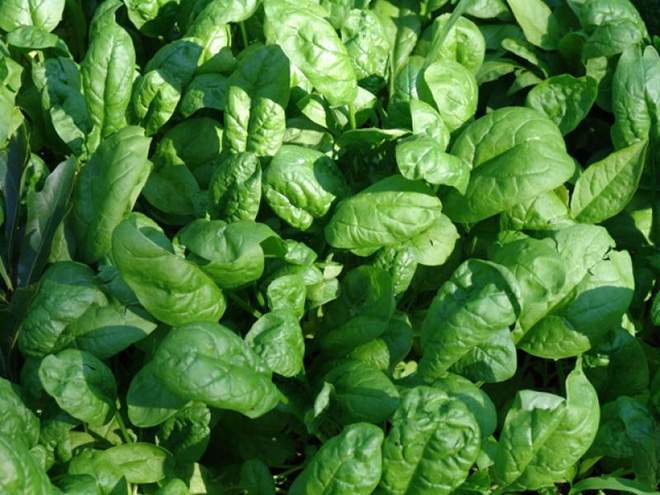
Garden spinach is an annual plant from the Amaranth family, a nutritious type of greens used for food. The word spinach means green hand.
For culinary purposes, a rosette of leaves is used, which is formed at the beginning of the growing season. The leaves are smooth or rough to the touch, triangular-lance-shaped or oblong-ovate. The stem reaches a height of 30 centimeters.
In the wild, spinach was found in Western Asia. It was originally grown in Persia. Later it was brought to China along the Great Silk Road, where in the middle of the 7th century it became known as a "Persian vegetable".
The first time the Arabs mentioned the cultivation of spinach in the writings of the 11th century. The plant has long occupied an honorable place in their diet. They even dedicated treatises to him, and Ibn al-Avvam called him "a general among the greenery."
Europeans learned about spinach no later than the 13th century. The Italians considered this vegetable a spring vegetable and recommended eating it during Lent.
Spinach gained unprecedented popularity thanks to the Queen of France, Catherine de Medici. She demanded that it be served with every meal. Over time, the use of this greenery became fashionable among the royal courtiers.
Once upon a time, spinach was used both fresh and boiled (rolled into balls). In the middle of the 16th century, people began to grow a plant variety with wide leaves, pleasant taste and round seeds. In the 16th century, several types of spinach were known to mankind. Healers mixed it with granulated sugar and prescribed it to their patients as a laxative.
In Russia, this vegetable began to be actively used in the middle of the 18th century. Until the end of the 19th century, it was used exclusively by aristocrats.
What it looks like and where it grows
Externally, spinach is a herb with rounded or notched leaves of various shades of green. Distinguish between male and female forms of the plant. The female one is distinguished by large leaves, the male one is smaller and more rare.
Garden grass reaches 30-40 cm in height. But some types of spinach are much higher - from 80 cm to 3 m.There are 5 main types of plants and many of its subspecies (varieties):
- The garden view is considered the most common. This annual plant is represented by varieties: gigantic (used in the production of canned food), godry and virofle (resistant to low temperatures), stoic.
- Tetragonia (New Zealand) - has fleshy leaves. It differs from other varieties in its suitability for food, even during the ripening period.
- Zhminda (many-leaved Mary) - has berries that look similar to raspberries.
- Basella (Ceylon or Malabar) is a tall, liana-like species.Possesses a perennial root system.
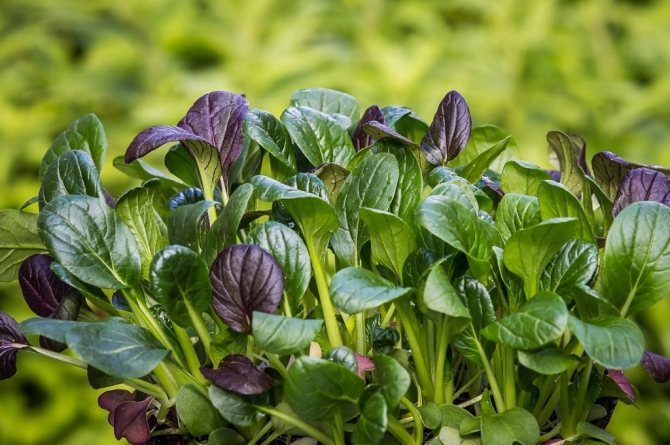

Japanese spinach
Stoic in the post-Soviet space began to grow only in 1995.
From the Iranian language, the word is translated as "green hand". In France, the plant is also called "stomach broom".
Composition and calorie content
There are about 23 kcal per 100 g of the product.
Food value:
- proteins - 2.9 g;
- carbohydrates - 3.6 g;
- fats - 0.4 g.
Healthy spinach contains a huge amount of vitamin A (469 μg per 100 g), folic acid (194 μg per 100 g), ascorbic acid (28 μg per 100 g), vitamin K (483 μg per 100 g), β-carotene (5626 μg per 100 g).
The vegetable also contains vitamin E, calcium, magnesium and iron. Fresh herbs are rich in antioxidants.
The trace elements iron and calcium that enter the body when eating spinach are difficult to assimilate. This is due to the large amount of phytic acid and especially oxalates that make up the greens. The body of a healthy person is able to assimilate no more than 5% of the calcium found in vegetable crops.
How to choose
Spinach is not picky about the composition of the soil and can grow in soil containing heavy metals, so the choice of the product should be taken seriously. The leaves of a healthy crop have a uniform green color without yellow blotches and dark spots. The degree of bitterness depends on the thickness of the stem: the thicker it is, the more bitter the spinach dish will taste.
Texas spinach producers have erected a monument to the cartoon character about the sailor Popeye in the city. According to the scenario, a sailor eats a leaf of a plant, after which he becomes a real hero. Growth in sales of vegetable grass after the release of the cartoon increased significantly.
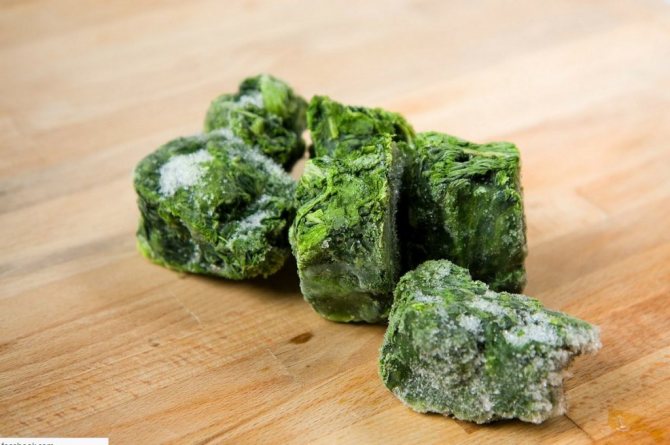

The frozen product retains all useful properties
Application of spinach
In cooking.
Young spinach is consumed fresh, adding it to salads and sauces. Old leaves are fried, stewed and steamed. A delicious and light soup is prepared from a vegetable culture. Greens go well with cheese, bacon and cream.
In the refrigerator, spinach can be stored for up to 8 days. The more the product is chilled, the less vitamins and nutrients it contains. In order to increase the life of a vegetable, it is pressed, rolled into balls, and then frozen. In such conditions, the leaves are stored for up to 8 months. After thawing, they are used for cooking or stewing.
In medicine.
Spinach juice is drunk in the morning on an empty stomach to restore energy and cleanse the body. This drink normalizes the functioning of internal organs, including the functioning of the liver, intestines and kidneys. It is used for dry coughs and asthma.
Spinach juice has a calming effect. It is used to rinse the gums and throat for inflammatory diseases, and is also added to other juices. It is enough to take 1-2 glasses of spinach juice a week (athletes need to increase this amount).
Fresh leaves are kneaded and applied to the affected areas to relieve inflammation and swelling, as well as eliminate abscesses from insect bites. These parts of the plant are mixed with olive oil, boiled, and the resulting paste is used to improve complexion, remove freckles, treat eczema and burns.
In industry.
Spinach is used for the production of various dyes. It is also added to canned foods and condiments.
When the plant is useless or can harm
But, contrary to popular belief, spinach does not have anti-cancer properties. The benefits of spinach for weight loss, which are mentioned by many healers or even nutritionists, are also questionable. On the one hand, the fiber that makes up all the structures of spinach leaves is not digested either in the stomach or intestines, and therefore takes a place in them that could be occupied by food. As a result, the feeling of hunger decreases, and satiety increases.On the other hand, any fiber physically "scrapes" the digestive tract, depriving it of the walls of the mucous layer, so necessary to protect against aggressive environments of the stomach and intestines.
Therefore, diets based only on the abuse of fiber end up with peptic ulcer disease much more often than the desired weight loss. Plus, the appointment of spinach for diseases such as pancreatitis and cholelithiasis, although they can be heard often, all the more "misses the mark" with the risk of causing serious harm to the body.
Through the efforts of breeders, spinach leaves have completely lost their bitterness over the past centuries. Therefore, they no longer stimulate the secretion of bile, although in the past they may have given such an effect. Plus, a high concentration of food acids in spinach is dangerous for the intestines, since with pancreatitis, the synthesis of alkaline juice by the pancreas, which can neutralize them, decreases or stops.
Restrictions on admission
First of all, spinach should not be consumed in case of allergies. It doesn't matter if it's on him or some other herbal products. There are many strong provocateurs of allergic reactions in spinach leaves, starting with ascorbic acid and ending with all its chemical “relatives”. Yes, and retinol does not lag behind them. Additionally, spinach contraindications relate to the following diseases.
- Gastritis. Especially if it is accompanied by normal or high acidity. Gastritis is an inflammation of the lining of the stomach. A variety of factors can lead to it, and some of them, moreover, remain a mystery to science. But the mucous layer on the inflamed area almost always becomes thinner, and the cells of the organ wall itself begin to produce either more hydrochloric acid or less. Therefore, untreated gastritis is usually accompanied by a change in acidity in one direction or another, ending with the formation of an ulcer. If the acidity is low (the patient has hypoacidosis), taking additional servings of it with spinach leaves will generally affect the stomach and digestion for the better. However, you need to understand that oxalic and other acids can come into contact with inflamed walls, causing pain. And eating spinach with high acidity will not only increase them, but also lead to heartburn, as well as accelerated formation of erosion.
- Stomach ulcers. Or intestines. Already ready-made erosion of the digestive system with any localization by itself excludes eating foods containing irritants like spices, acids (including vinegar), etc. From such food, the patient's pain sensations intensify many times, acute spasms, diarrhea, nausea and vomiting may occur, bleeding may open.
- Gout. In principle, gout is a violation of the metabolism of uric acid - one of the breakdown products of protein, a concentrate of sodium salts. In other words, uric acid does not enter the body from the outside and has nothing to do with the composition of spinach. It is formed in itself during the digestion of proteins from food. Nevertheless, gout as a pathology affects the exchange of many acids, not limited only to urinary. Their exchange in the patient's body also proceeds not without problems, or even is frankly violated. In addition, all acids, including food acids, are excreted from the body in the same way - through the kidneys. And their activity in gout is disrupted due to the accumulation of sand in them first, and then stones formed by reddish urates (uric acid salts). Therefore, no one will guarantee an improvement instead of a sharp deterioration in the course of gout when taking spinach, and official medicine does not recommend such a combination.
- Oxalaturia. But oxalates, unlike urates, are salts of oxalic acid, which is so rich in both sorrel and spinach.The presence of oxalate sand or kidney stones is a direct and strict contraindication to the intake of not only spinach, but also any vegetables / fruits with a pronounced sour taste, including parsley, lingonberries, currants and citrus fruits.
It is not forbidden to eat spinach during pregnancy and breastfeeding, but you should not get carried away with it. First, reviews of spinach as a multivitamin and mineral supplement show that it is still not enough to compensate for deficiencies that arise at this time. Secondly, the likelihood of developing side effects in the form of the same allergy in the baby has not been canceled either. It is undesirable to give highly allergenic foods to children under one year old, and spinach is just one of them.
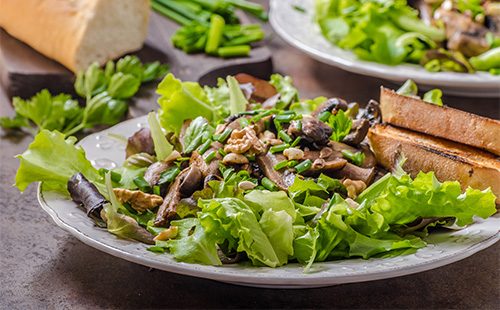

Useful properties of spinach and contraindications to its use
Beneficial features:
Spinach holds the record for vitamin A content, second only to carrots. Its use saturates the body with useful substances, normalizes metabolism and starts the process of energy production. High iron content activates the activity of hemoglobin and contributes to the saturation of cells with oxygen. In stressful situations, this vegetable helps to restore good mood and performance.
The inclusion of spinach in the diet stimulates the activity of the pancreas and sebaceous glands, helps prevent retinal degeneration and improve visual acuity.
Spinach is considered a dietary product, has a laxative effect, eliminates edema, relieves inflammation, and is characterized by an anticonvulsant effect. It helps to strengthen teeth, gums, prevents the development of anemia and neoplasms, strengthens blood vessels, tones, normalizes the functioning of the pancreas and intestines.
Spinach is useful for children and pregnant women, as well as for people suffering from hypertension, diabetes mellitus, enterocolitis, gastritis, anemia, nervous disorders, radiation sickness. It is indicated for pneumonia, heart and vascular diseases, skin ailments, weakened immunity, for the prevention of Graves' disease. The use of this vegetable has a beneficial effect on the process of hematopoiesis. Salts of calcium, phosphorus, potassium, arsenic, copper, magnesium and sodium make this product useful for people in need of rehabilitation after a major operation.
Contraindications and recommendations for use:
Since spinach is rich in oxalates, it should not be consumed in case of kidney stones and a tendency to develop it. Heat treatment of a vegetable can reduce the amount of harmful substances in it by no more than 15%. Spinach is also contraindicated in rheumatism, gout, biliary tract, duodenal ulcer, liver disease.
With a sedentary lifestyle, you should not take vegetable juice more than a couple of times a week. Nutritionists allow the use of spinach for kidney stones and gout, together with milk and only after consulting a specialist.
Do not get carried away with eating a vegetable, as it contains oxalates and phosphates. This can lead to increased blood pressure and uric acid levels.
The benefits of spinach for a woman's body
Rich in iron, folic acid and vitamin E, spinach is a valuable product for the female body. This combination of substances is recommended to stabilize a woman's reproductive system and create a beneficial soil during conception and gestation. After childbirth (if there are no contraindications), it is useful to include this product in the diet of a nursing mother to improve lactation and saturation of the body with the necessary substances. Also, spinach in the diet is useful for recovery after childbirth. A good product for PMS and in a woman's menopause. The fact is that the green leaves of the plant are saturated with exactly those substances that are needed to strengthen the body after characteristic stress. Also, the composition of spinach is valuable for stabilizing hormonal levels.
A number of vitamins (E, A, K, B) help to maintain youthfulness and elasticity of the skin, strength of joints. With the use of this product in food, the heart muscle and blood vessels are strengthened, the risk of developing varicose veins and diseases of the cardiovascular system decreases. This product helps to maintain a healthy complexion, strengthens and beautifies hair and nails. Here's how much benefit women can get from choosing spinach for their diet.
Folk recipes
For the preparation of products, you must use fresh and washed spinach leaves.
Spinach juice.
Recipe: Squeeze the juice from the leaves. Drink the drink only freshly prepared. Indications and order of use:
- for constipation: 500 ml daily;
- with weakness, depression: 250 ml on an empty stomach in the morning.
Recipe and order of application: Mix 30 g each of carrot juice and spinach juice. Take 50-60 ml. drink 1-2 times a week. Indication:
- nervous overload.
Infusion of spinach.
Recipe and order of application:
1 tsp Pour the chopped leaves with a glass of boiling water. Leave the remedy for 1/4 hour, strain, take during the day. The maximum daily dose is 2-3 glasses. Indication:
- the need to increase urine output.
Recipe and order of application:
Chop 10 g of leaves, pour a glass of water. Leave the remedy for a couple of hours, strain and take 40-50 ml 3-4 times a day. Indications:
- chronic constipation, tuberculosis, flatulence, anemia, neoplasms.
Spinach poultices (for external use).
Recipe:
chop the leaves and pour over boiling soy or olive oil. Cool the mixture and apply on burns, fixing with a loose bandage. Change the compress every 2-3 hours, additionally rinsing and treating the burn.
Indication:
- burns.
Hair Care Product.
Recipe:
Pour 500 ml of water with 120-130 g of leaves, put on the stove and cook for 15 minutes. Then remove the broth from the burner, cool, strain and rub into the scalp. Wash your hair in an hour.
Indication:
- the need to improve the condition of the hair.
Decoction of spinach.
Recipe:
Chop 10 g of leaves, pour a glass of water (boiled). Put the product on fire and cook for about 12-15 minutes, leave for 1.5 hours. Take 50 ml of broth 3-4 times a day for 1/3 hour before meals.
Indications:
- chronic constipation, swelling, flatulence.
Spinach gruel.
Recipe and order of application:
- Chop 60 g of leaves and sprinkle with a little cinnamon. Consume the product in 3-4 days.
Indication:
- depression.
Spinach photos
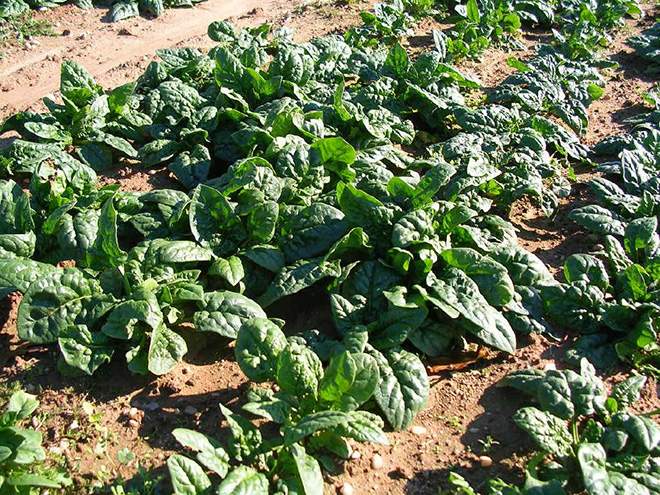

Interesting facts about spinach
1. For a long time, spinach was mistakenly attributed to miraculous properties. So, in the XX century, the inhabitants of Europe believed that it is extremely rich in iron. Doctors have recommended this herb to their patients. As a result, it turned out that iron in spinach is exactly 10 times less than it was believed for a long time. False information appeared due to the fact that an American scientist mistakenly wrote down the results of research. In fact, fresh spinach is about 90% water, and contains only 3.5 mg of iron.
2. French women actively use spinach for cooking various dishes. They rub the skin with the juice of this plant to preserve youth and beauty.
3. According to some reports, spinach is a vegetable overloaded with pesticides. In 2006, an epidemic of Escherichia coli O157: H7 took place in 26 American states, which caused the death of 3 people. The reason was the sale of underwashed spinach from California. To avoid unpleasant consequences, the greens were washed three times and this information was indicated on the packages. In 2008, the US department allowed the plant to be treated with ionizing radiation that kills microbes.
4. US residents include spinach in their children's diet. They believe that these greens have a beneficial effect on the growth and development of the skeletal system.
Conclusion about spinach:
Spinach is extremely rich in nutrients and has many health benefits, but it must be eaten with care as it can be beneficial and harmful. Before self-medication, you need to consult a doctor and make sure there are no contraindications.
Rate the material:
No ratings
Admin
12.08.2015
1995
1
Found a bug? Highlight it and press Ctrl + Enter
Report a bug
Similar posts
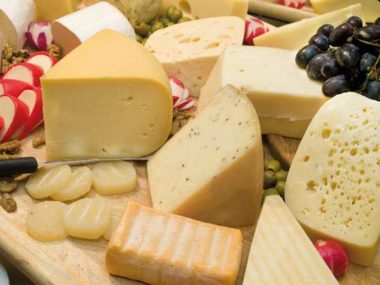

Introducing 18 hard cheeses


Red cabbage: benefits and harms. Application, recipes, photos
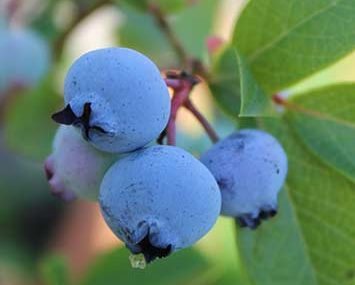

Vegan okroshka with spinach recipe
To prepare snacks popular in Georgia, you will need:
- Spinach - 350 g.
- Cilantro - 1 bunch (100 g).
- Garlic - 3 cloves.
- Sour milk - 500 ml.
- Spices (salt, pepper) - 0.5 tsp.
Step-by-step instruction:
- Spinach is boiled for 3-5 minutes in salted water. Wring out, crushed into strips.
- Garlic and cilantro are crushed into gruel. Spices are added.
- Sour milk is passed through cheesecloth, draining the whey. Chopped spinach and garlic are added to the residue.
The ready-made appetizer is served as a light cold soup. You can make the dish more satisfying by adding fried onions and ghee to it.


The best varieties for growing in the middle lane
In the middle lane with a temperate climate, many varieties of spinach grow favorably. These include:
- Victoria;
- Stoic;
- Virofle;
- Bloomsdelsky;
- Gigantic;
- Fatty;
- Matador;
- Strong guy.
Of course, you can try growing other varieties as well.
New Zealand (Tetragonia)
This mid-season variety belongs to the crystal family. The bush grows up to 1 m, and its rich green leaves spread along the ground. They are thick and fleshy, resembling jagged triangles.
The seeds have good germination, but the variety is extremely picky about light and frequent watering. It rises in 20 days. Seedling planting is considered the most successful for growing. The New Zealand variety yields many times, and pruning can be done after 25-30 days.


Godry
An early variety for cultivation in greenhouses, greenhouses and greenhouses. In addition, the crop can be successfully grown outdoors from early May to late August. It tolerates small frosts well. Godry rosettes are formed from 18 to 30 days after germination. They are quite dense, but compact - about 23 cm in diameter. The leaves are ovoid, green.


When cultivating the variety, you need to be careful, since it is prone to early flowering.
Rumex
The variety is obtained by crossing spinach with sorrel, therefore, in another way, it is called "schannat" or vegetable-bogatyr. It belongs to perennial crops that tolerate frosty winters well and are distinguished by the rapid growth of green mass.
This variety is good not only for people, but also for domestic animals and birds (chickens, geese, rabbits, ducks), as it has the richest composition of nutrients. When nitrogen fertilizers are applied, like bamboo, it can reach almost 2 meters in height, so it is given to cattle and pigs. The leaves are juicy, large, and have a sour taste.
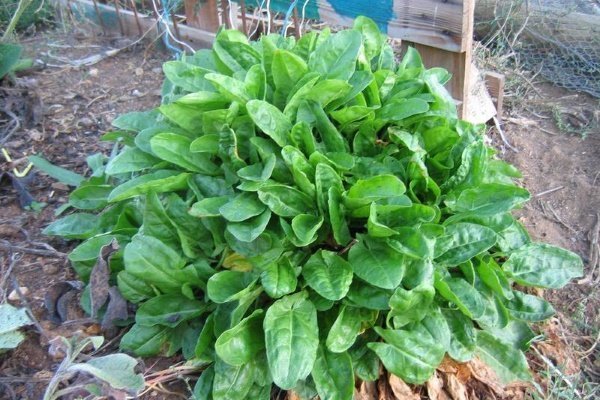

Strawberry (zhminda)
This type of spinach attracts gardeners because it has a strong root system (even the roots remaining for the winter can give growth). The plant is somewhat similar to strawberries, which is why it is called Strawberry. Requires growing in open beds, well lit by the sun. The leaves grow with small denticles at the edges.
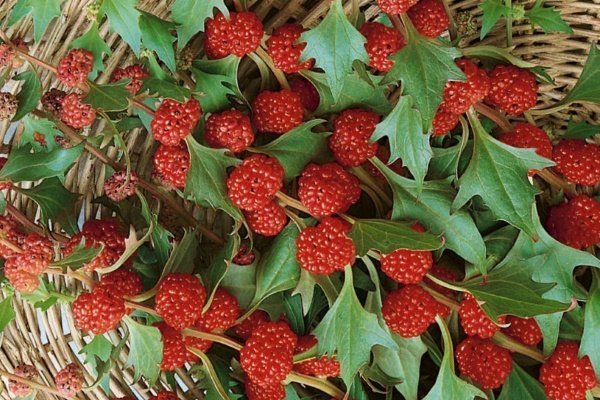

Edible berries. They taste sugary sweet.
Growing
Garden spinach is unpretentious and easy to grow. Fresh greens can be obtained from early spring to late autumn with new crops every 15 days, starting in mid-April.
This vegetable should not be planted where carrots used to grow. Cucumber, potatoes, and cauliflower are recognized as good predecessors.
It is necessary to start preparing the soil in the fall: dig it up, apply complex mineral fertilizers with a low nitrogen content. If necessary, liming is carried out at the same time. In the spring, the soil is loosened and a little urea is added.
Before planting, it is recommended to soak the seeds for 2 days in warm water, changing the liquid several times. Slightly dried planting material is buried in moist soil by 1.5–2 cm. It is advisable to cover the planting with non-woven material.
Seedlings appear within 7-10 days. Seedlings must be thinned out. Harvesting begins when more than 6 leaves are formed in the outlet. They are either selectively cut from different specimens, or the whole plant is uprooted.
Podzimny sowing is also possible. In this case, gardeners get fresh greens to the table much earlier than with spring sowing.
If your plans include getting seeds, you should select a few different-sex spinach. The foliage is not cut off from them. After flowering, all male plants are harvested. As soon as the leaf blades turn yellow, the stems are cut from the female specimens. They are hung up and ripened. The dried seeds are stored in paper bags.
Planting and caring for garden spinach
The cultivation of this garden green has its own specifics, which should be taken into account for harvesting the leaves. In the south, green crops are sown in open ground before winter and early in April or even March. In the areas of the middle lane in the spring they grow under the film and also sow in the fall. Many varieties are cold-resistant, seeds germinate at temperatures above + 3 ° C. A salad garden culture grows well in greenhouses, where it is used as a sealant in areas with tomatoes, eggplants, and bell peppers.
Landing site preparation
The soil for spinach should be nutritious and constantly moisturized, because the roots of the plant are short, located close to the surface. For sowing seeds of early spring garden greens, the following areas are excluded:
- dry;
- with sandy soil;
- sour;
- located in a draft.
The beds are laid out in a sunny place protected from the north wind. The culture tolerates light partial shade that falls on the site at lunchtime. In the garden, fertilized in the fall with organic matter, in the spring they add 1 sq. m the following mineral preparations:
- 10-15 g of urea;
- 15 g of potassium sulfate;
- 30 g superphosphate.
Also use 30-50 g of complex preparations with an approximate percentage.
Seed preparation
Untreated seeds are soaked in water at room temperature for 20-30 hours. If desired, then you can treat with growth stimulants according to the instructions. Dry the seeds before sowing.


Landing rules
Spinach is sown in rows with a distance of 30 cm or ribbons, in which 2-3 lines are placed. An interval of 20 cm is observed between the lines, and up to 50 cm between wide strips. The sowing depth is different for the types of soil:
- in dense - 2.5 cm;
- on loams and sandy loams - 4 cm.
After sowing, the soil is slightly compacted. The first shoots appear in 6-8 days.
Watering and feeding
Spinach is a moisture-loving garden crop. Leaves are firm and fleshy if the bed is sufficiently moisturized. Otherwise, the plant begins to shoot quickly. They take special care of timely watering in the south. If it rains and the weather is cool, watering is not needed, because with an excess of moisture, fungal diseases develop. After the appearance of 2-3 leaves, the crops of garden greens are fed with solutions of organic matter and wood ash. The fertilization is repeated after 9-12 days.
Attention! When feeding, take into account that vegetable spinach accumulates nitrates. Therefore, nitrogenous substances should not prevail. As well as an excess of potassium, after which the garden crop will quickly create seed arrows.
Weeding and loosening
At the first weeding, the crops are thinned to an interval between plants of 10 cm.Loosening retains moisture in the soil, removes weeds. The foot is deepened by 6-7 cm, being careful not to damage the spinach roots. Mulching of row spacings is also used.
For children
Cooking spinach for children is primarily preventive. The development of the child's body occurs gradually and the beneficial substances contained in the product contribute to the full improvement of all systems.
- You can give spinach to babies from 6 months. The product is excellently used as a complementary food for babies up to one year old.
- Lack of calcium, frequent constipation and anemia in infants can also be eliminated by the constant intake of the vegetable.
- Before making the spinach puree, you first need to give the child juice from this product for about a week so that he gets used to it.
What dishes are added?
The culinary uses of this product are enormous. Fresh spinach is added to salads and sandwiches, they are seasoned with fried eggs for breakfast, soups are made from spinach for lunch, it is used to make sauces, seasonings and as an addition to meat dishes for dinner, added to pasta, to the filling of pies or pancakes, and lungs are prepared smoothie drinks as snacks.
Stewed or fried spinach can be a stand-alone dish. The national cuisines of some countries, for example, Georgia, are inconceivable without this product.
The glory of the king of greens is not in vain for spinach. Easy care, quick harvest, useful properties and a variety of cooking options are a sufficient reason for spinach not only to become a constant dish on your table, but to grow in your garden or windowsill.
The soil
Spinach is picky about the condition of the soil. Therefore, it must be prepared in advance, fertilized and checked for acidity, the level of which should be 6-7. Spinach prefers fertile, moist soil.
Heavy and hard clayey soil, calcareous or calcareous soils are not suitable for growing it.
If heavy soil is used for planting spinach, organic fertilizers must be used. Nitrogen fertilizers are not recommended as the plant accumulates nitrates from them. By the time of planting, the soil should be warmed up to at least 2-4 degrees.
Spinach varieties popular among gardeners
Spinach, along with radish, is considered one of the fastest growing horticultural crops. But selection does not stand still, therefore new varieties of it constantly appear, including those with reduced ripening periods.
Early spinach
Early spinach is harvested within 18-30 days after planting seeds in the ground. Most varieties are also suitable for sowing before winter. The following varieties are most popular with gardeners:
- Virofle. Differs in unpretentiousness even in comparison with "relatives". Plant height - up to 30 cm, rosette diameter is about the same. The main disadvantage is the tendency to shoot. The variety is intended exclusively for sowing in early spring, suitable for growing both in the open field and in the greenhouse. Does not suffer from lack of heat and sunlight. Lime-colored leaves.
- Godry. Usually grown indoors (greenhouses, hotbeds). To disembark in open beds, you will have to wait for the beginning of May. The disadvantage is the tendency to early flowering. The rosette is quite compact, with a diameter of 18–22 cm. The vegetative period is 18–24 days.
- Gigantic. The variety is one of the most popular in Russia. The leaves are ready for use in 30–35 days after planting the seeds, but the first rosettes can be cut after 15–28 days. It is widely used for canning, as it does not lose its taste during heat treatment. Seeds can be planted both in spring and before winter - the variety is cold-resistant, does not pay attention to sudden temperature changes. The leaves are elongated, fleshy, the diameter of the rosette reaches 45-50 cm.
- Marquis. The vegetative period does not exceed 35 days.The variety is versatile - it can be grown both indoors and outdoors, the seeds are planted from April to September. Leaves are oval, slightly corrugated. The concentration of vitamins and trace elements is very high, the benefits are preserved when frozen, canned, heat treated.
- Stoic. The variety is valued for its high yield (2-3 kg of leaves per 1 m²) and resistance to unfavorable climatic and weather factors (including short-term drops in temperature to 0 ° C). It was one of the first to grow in Russia and has not lost its popularity for more than two decades. Ideal for cultivation in temperate regions. The main disadvantage is the exactingness of watering and lighting. When grown at home, supplementary lighting is required.
- Strawberry. It is considered one-year, but shoots may well appear the next season if the roots of the plant remain in the garden. The leaves are thin, not too fleshy, the edge is serrate. The root system is developed, it is quite difficult to pull the bush out of the ground. The fruits are bright scarlet, from a distance they look like strawberries.
- Uteusha. Ukrainian hybrid, bred relatively recently. The leaves grow literally before our eyes, the yield is very high.
Photo gallery: early spinach varieties


Virofle spinach is extremely unpretentious


Spinach Godry is grown mainly in greenhouses and greenhouses Gigantic - one of the most cold-tolerant spinach varieties
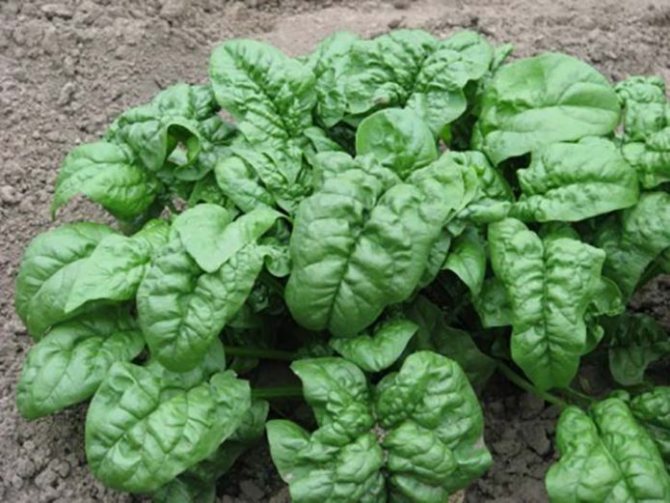

Spinach Marquise is prized for its high concentration of vitamins and minerals


Stoic is one of the most productive spinach varieties


Uteusha is a new interesting spinach variety from Ukraine
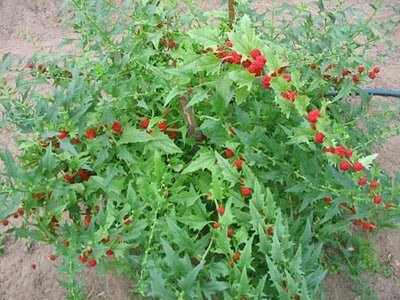

Strawberry spinach looks very impressive, but the gardeners' reviews about it are opposite.
Mid-season varieties
The ripening period of mid-ripening spinach varieties stretches for 35-60 days. To speed up the process, it is recommended to pre-germinate the seeds by soaking them for 1-2 days in a pale pink solution of potassium permanganate. The following varieties are most popular in Russia:
- Bloomsdel F1. One of the newest Dutch breeding hybrids. Plants do not shoot, the harvest depends little on the vagaries of the weather. The culture does not suffer from frosts, torrential rains, and other unpleasant surprises. The rosette is rather large, up to 25 cm in diameter. Leaves are fleshy, rich green with small rounded specks of salad shade (the so-called bubbles).
- Fatty. The achievement of Russian breeders is characterized by high yields. Easily adapts to almost any climatic and weather conditions. The growing season is 35–40 days, the diameter of the rosette is 25–28 cm. The leaves are rich green, smooth to the touch.
- Strong guy. The leaves are ready for consumption no later than 40 days after planting the seeds. The rosette is compact, 23–25 cm in diameter. The leaves are semi-raised, light green, glossy. The variety is very hygrophilous, so watering the plants requires regular and timely watering. A significant plus is genetically built immunity against mold and rot.
- Matador. The variety is originally from the Czech Republic. Does not shoot. The leaves look very attractive - juicy, fleshy, crunchy. They are painted bright green with a grayish undertone, smooth, glossy. The growing season lasts 35-50 days. The rosette is compact, 25–27 cm in diameter. The variety is not highly drought-resistant, but it has immunity against most diseases typical for the culture, is insensitive to waterlogging of the soil, lowering temperatures.
- Mariska. The variety is valued for its cold hardiness and high immunity. The growing season is 35–40 days. The leaves are large, juicy and very tender, with a high iodine content.
- Victoria. The growing season extends over 32–45 days. Seeds are planted from mid-spring to autumn.The variety is suitable for growing in open and closed ground, practically not affected by mold. The bushes are compact, the rosettes are small, with a diameter of 18–20 cm. The plant gratefully responds to complex nitrogen-phosphorus-potassium fertilizers with a sharp increase in yield.
Photo Gallery: Medium Ripen Spinach Varieties
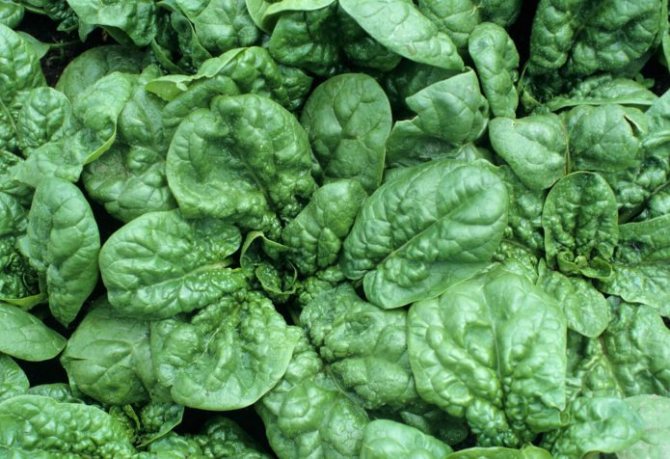

Spinach hybrid Bloomsdell F1 - one of the latest achievements of Dutch breeders


Fat-leaved spinach is distinguished by the presence of large, juicy, fleshy leaves
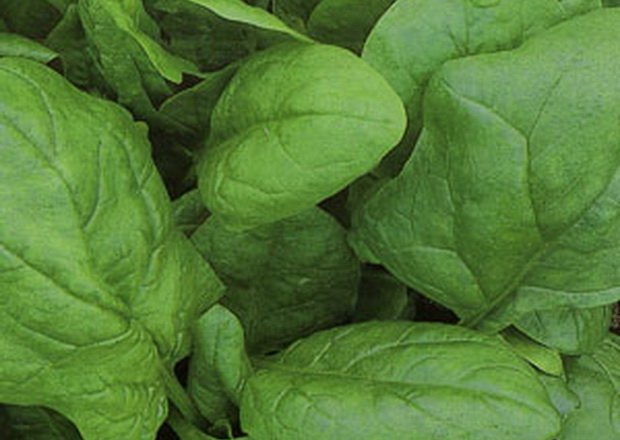

Spinach Krepish stands out for its moisture-loving nature against the background of the main varieties.
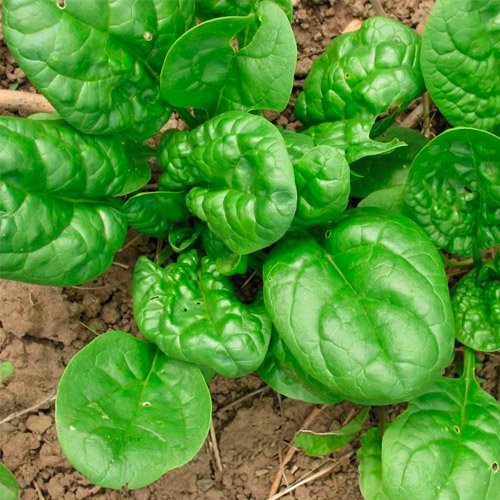

Matador is a common medium-ripening spinach from the Czech Republic.
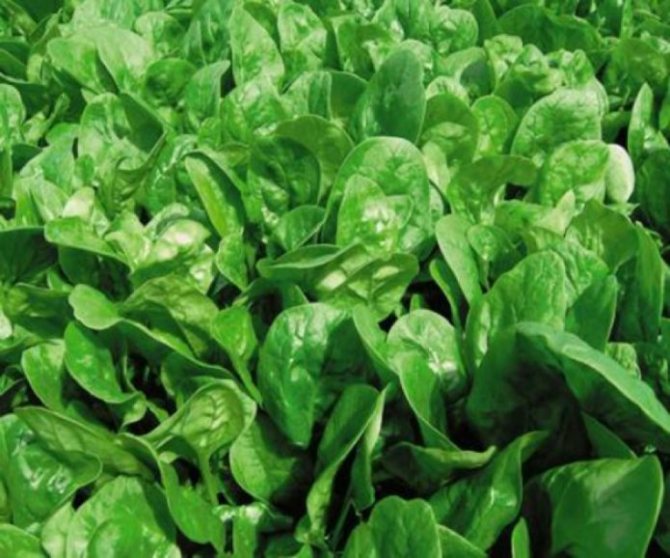

Spinach Victoria is one of the most popular varieties among Russian gardeners.
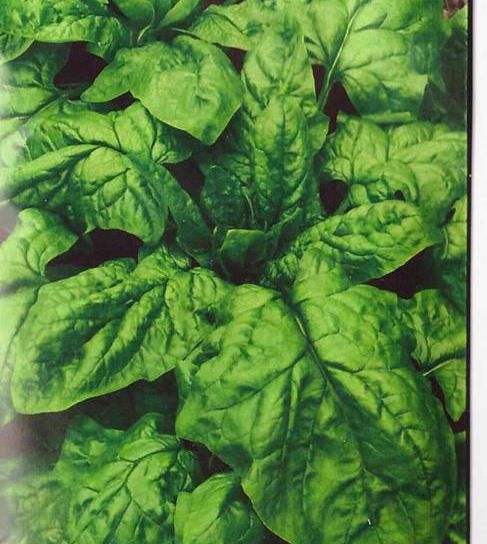

Mariska spinach variety is characterized by insensitivity to low temperatures and good immunity
Late spinach varieties
Many gardeners prefer to grow late varieties of spinach. Practice shows that its leaves are more juicy and crunchy. This is due to the fact that the weather at the end of summer is cool, the days are getting shorter. Therefore, the plant directs all its forces to the formation of greenery, and not to the ripening of fruits.
Of the late varieties, the following are common:
- Corenta F1. The variety is intended for outdoor cultivation only. The rosettes are large, the leaves are of a deep dark green color. Productivity depends little on weather conditions, but proper watering is required.
- Spokane F1 is considered by most experts to be the best of the late varieties. It is widely grown abroad on an industrial scale. Ecological "plasticity" allows getting a bountiful harvest even in extremely unfavorable seasons from the point of view of weather conditions. Also, the variety is valued for its high immunity to fungal diseases; it is rarely attacked by pests. At the same time, plants are sensitive to moisture and light deficiencies. The surface of the leaf is slightly wrinkled, the edges are corrugated.
- Varangian. The socket is compact, half-raised. The leaves are almost round, bright green, the "bubbles" are pronounced. The taste is clearly distinguished by a slight sourness. The variety is well suited for preparing salads and first courses.
Photo Gallery: Late Spinach
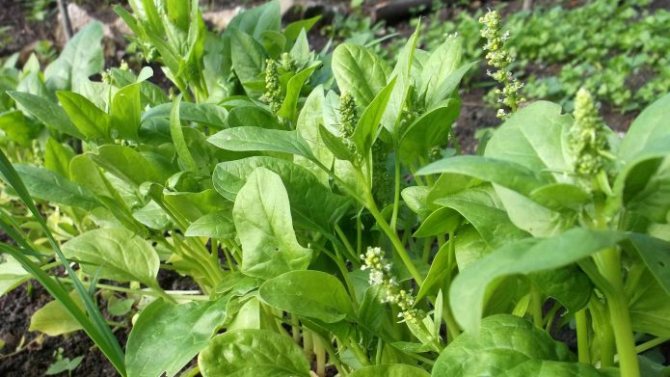

Spinach Corenta F1 is only suitable for outdoor cultivation
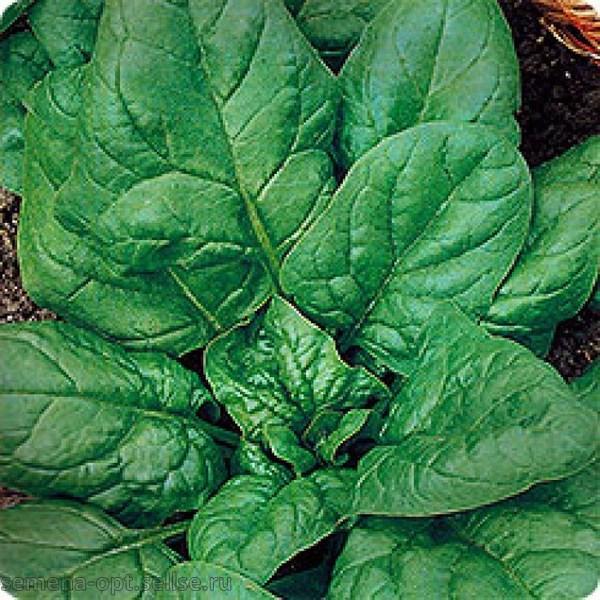

Spokane F1 - a variety of spinach grown overseas on an industrial scale
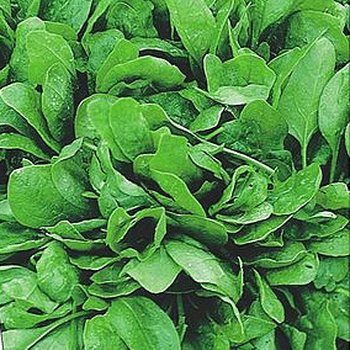

Varyag spinach is widely used in cooking
Also, the so-called New Zealand spinach, known to botanists as tetragonia, is also often grown. It has nothing to do with ordinary spinach, they belong to different families. Nevertheless, tetragonia surpasses ordinary spinach in taste and the content of some trace elements. Its seeds are large (about the size of a child's fingernail), you will have to wait a long time for seedlings. Plant height - 0.8–1 m, stems very intensively branching, leaves are thick, triangular, the edge is carved with denticles.
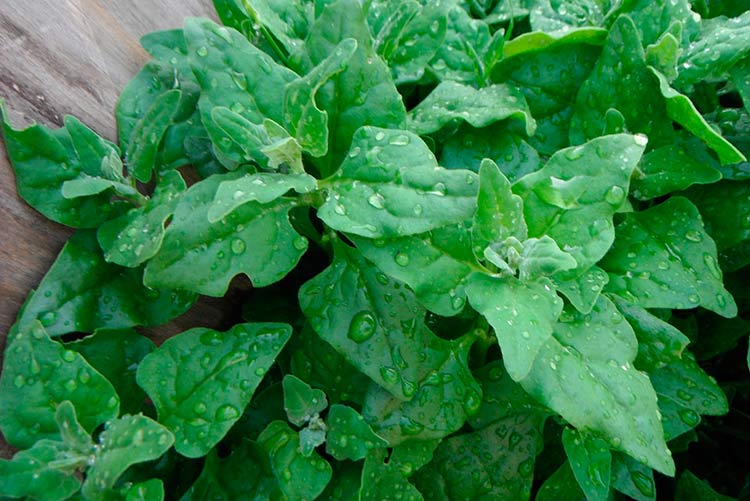

New Zealand spinach is superior to the usual one in terms of the size of the bush and the benefits for health
There is also multi-leaved spinach, aka Zhminda... In Russia, he is practically unknown. In addition to useful leaves, berries ripen on the plant, which taste like mulberries. They are used for making compotes, preserves, and other homemade preparations.
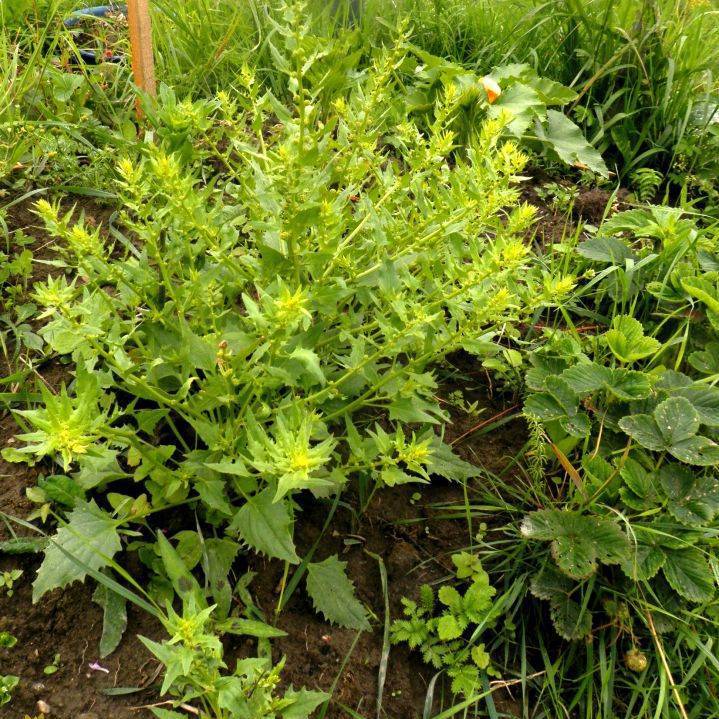

Many-leaved spinach is not only healthy greens, but also delicious berries.
An interesting variety is Indian spinach, or Basella... It is also not a "relative" of regular spinach. In nature, this is a perennial plant, in central Russia it is grown as an annual. Its stems are curly. It is often cultivated at home as an indoor flower.
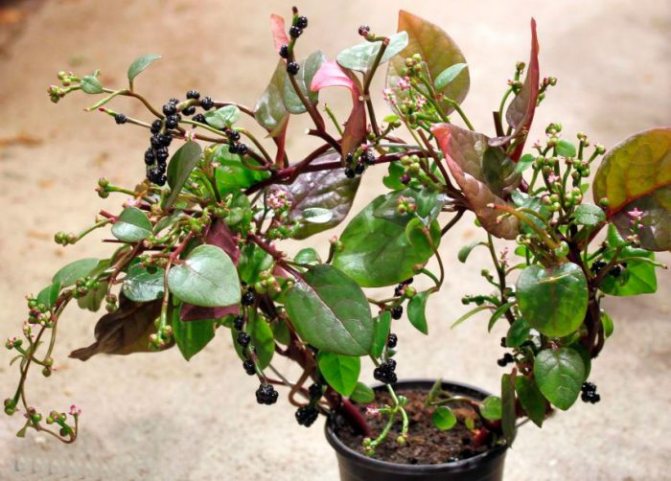

Indian spinach is more often grown not in the garden, but at home as an ornamental plant.
Useful elements
The composition of spinach is really varied. A vegetable accumulates many biologically active substances.
- The product contains the main building material for the body - proteins, as well as carbohydrates and fats that a person needs. In terms of protein content, spinach is second only to beans and peas.
- The culture also contains dietary fiber - fiber, necessary starch and fatty acids.
- Spinach in the leaves contains the entire group of B vitamins, and biologically active substances such as A, C, E, H, K, PP and beta-carotene. At the same time, many of the elements retain their usefulness after cooking the vegetable.
- Among the mineral type of substances in the vegetable are magnesium, calcium, phosphorus, zinc, potassium and manganese.
In cosmetology
Spinach is widely used in cosmetology due to its excellent cleansing properties. It is part of tonics, lotions. But its main application is for face masks. They do an excellent job with a fine mesh of wrinkles on the skin in the eye area, rejuvenate the skin, make it smooth and velvety.
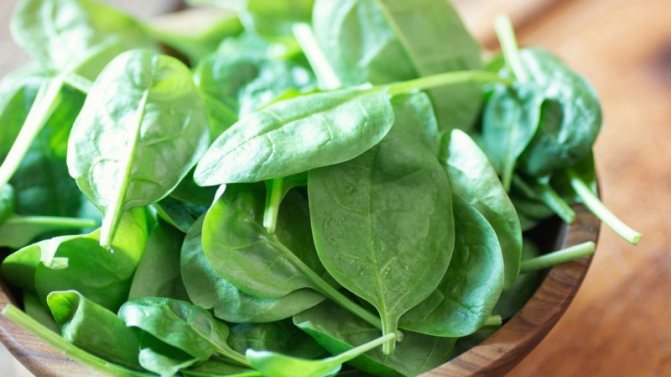

- To make a mask to reduce wrinkles surrounding the eyes, you need to grind several leaves of spinach, it is convenient to do this in a coffee grinder, then squeeze the juice out of them, mix it with vitamin A in oil: one teaspoon of juice is mixed with ten ml of an oil solution. A cream intended for the skin around the eyes is added to the mixture, enough tea. spoons. The mask should be kept for about half an hour. It can be removed well with a swab dipped in boiled chilled milk, while the skin receives additional nutrition.
- To rejuvenate the skin, you need to make a mask of chopped spinach leaves, boiled in milk. We put the leaves on cheesecloth and hold on the face like a compress. We wipe the skin with lotion. This mask is especially good if the skin is irritated.
- To whiten the skin, you need to mince spinach and sorrel leaves, each with a tablespoon. We dilute them with a tablespoon of kefir. We apply the mass on the face and neck, hold for 20 minutes. You can wash off the mask with warm water. If washed off with milk, the effect will be better.
- The rejuvenating mask is cold. Freeze spinach juice in ice cube trays. Wipe your face with a piece of spinach ice every morning.
Advice
- Choose young spinach leaves. They crunch slightly when pressed. Older leaves will have more harmful substances and a bitter taste.
- The appearance of the product plays an important role. There should be no spots on the spinach leaves, and the shade should only be green.
- After collecting spinach from the garden, it can be stored for no more than a week. The content of leaves for more than 2 days and outside the refrigerator leads to the appearance of toxic substances in the product.
- The autumn harvest of the vegetable has a richer taste, its leaves are strong and juicy compared to the spring harvest. The exception, perhaps, is strawberry spinach, which tastes great after winter. By the way, this type of plant can be used with berries.
- The freshness of the spinach can be increased by placing the leaves in a bowl of water. Frozen spinach is the best option for those who don't want to consume it right away. In frozen form, the vegetable is stored for a little more than six months.
Photo
Below you will see the photos of the plant.
History
- For the first time spinach appeared in Persia, in the Middle East. Ancient peoples cultivated this vegetable even before the beginning of our era.
- The introduction of spinach to Europe is sometimes associated with the Moors and sometimes with the Crusaders.
- The first European country to start cultivating this crop was Spain. The monks were engaged in the cultivation of spinach on the territory of the monasteries.
- Then the spinach ended up in the rest of Europe. He gained particular popularity in France, where he is considered the king of vegetables in the garden and a "broom" for the stomach.
- After the discovery and development of America, culture was brought to this continent as well. In the United States today, spinach is used by residents of various states.
- The vegetable was brought to Russia 200 years ago. Unfortunately, it has not received wide distribution among the people to this day.Perhaps this is due to the fact that it does not have a strong taste and cannot be stored for too long.
Selection and storage
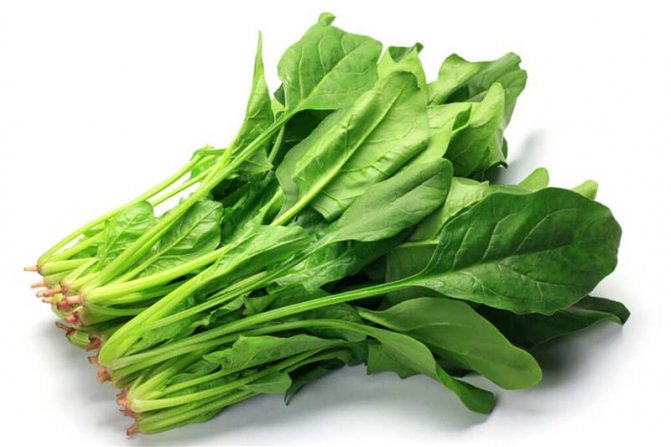

For eating, it is necessary to choose young dense leaves of a bright green hue, without spots, darkening or blotches. When bent, the sheet should crunch slightly, which indicates the freshness of the product. You should not buy soft, flabby spinach of a dull or dark green color, because a lot of nutrients are lost during long-term storage. You need to store the bundles for no more than 3 days in the refrigerator, packed in a plastic bag. A good option for short-term storage is a plastic container or container (jar) of water. Spinach should not be kept near bananas and apples, which give off ethylene, which can quickly spoil the plant. In winter, you can buy frozen leaves, the shelf life of which reaches 2-3 months. If you properly preserve the nutrients of spinach, then, using the example of the hero of the famous cartoon in the 90s - the hefty sailor Popeye, you can get an amazing source of strength and vigor!
What spinach is eaten with
You can make a variety of vegetable salads based on spinach. Greens go well with other vegetables. An omelet with spinach leaves is a great way to start and end your day. You can take a sandwich with you for a snack, which will be based on a tender spinach leaf. In addition, it can be added to vegetable stews or used as an independent side dish for meat and fish dishes. In this case, you can use both fresh and stewed leaves. Spinach is consumed bland, or a little salt or soy sauce is added.
For men
For the stronger sex, doctors often prescribe a vegetable intake at different ages. For men, it serves as an irreplaceable assistant in stabilizing the reproductive system, and also contributes to the overall improvement of the body.
- The content of lutein reduces the risk of cardiovascular disease.
- Spinach contains a large amount of potassium, which helps to improve blood pressure and reduce the harmful effects of sodium on the body.
- The amino acids found in spinach improve protein synthesis for beautiful muscle building.
- Polyunsaturated acids improve erectile and other functions of the reproductive system, and folic acid saturates the tissues of the penis with blood, ensuring its flow.
- Zinc accelerates the production of male hormones, primarily testosterone. In addition, the consumption of spinach is an excellent prevention of prostatitis.
- Due to the high content of the vitamin tocopherol, the use of spinach helps to normalize the functioning of the prostate gland and control hormonal levels.
The famous character Popeye, got immense strength from spinach.
The use of spinach for women plays a big role in weight loss. Also, the intake of the vegetable improves the appearance.
- Spinach products make hair strong and shiny.
- Facial treatment with this product improves color and removes minor imperfections of the skin.
- The fiber in spinach completely eliminates useless waste products in the body.
- The cleansing of all internal systems is also possible due to the good laxative effect of the vegetable.
- Spinach perfectly emphasizes muscle relief and is indispensable for girls attending fitness.
What can be replaced?


If you don't have fresh spinach on hand, you can use other crops. What does the plant look like? A close relative of spinach, sorrel has not only a similar appearance, but just like spinach, it is rich in vitamins and minerals.
Contraindications to the use of both plants are similar. However, they differ in taste. Sorrel leaves are sour, while spinach has a bitter taste. You can find all the differences between spinach and sorrel here.
If the goal of a replacement is to find a product that tastes similar, take a closer look at Swiss chard leaves or Chinese cabbage.
Description of the plant
- Spinach is an annual amaranth. The time from emergence to maturity of leaves takes only a month.
- On a low stem (60-80 cm), large, triangular-shaped leaves are alternately located. To the top, they become shallow.
- Small green flowers are collected in paniculate inflorescences. Pollination of the plant occurs through the air, with the help of the wind, so it will not be difficult to get seeds on your own.
Attention! Spinach is a perishable food. You need to buy only dense, crispy leaves that do not have any spots.
Diseases and pests
In thickened plantings that have not been thinned out, fungal and viral diseases can develop in cool weather, constant rains or excessive watering:
- root fusarium rot, especially common in the northwestern regions;
- downy mildew;
- various spots;
- mosaics and curls, which greatly reduce the yield.
The affected bushes are removed. If a disease is detected on the site, the same culture is sown only after 3-4 years.
Many pests of greenery - miner flies, caterpillars, aphids - are first bred on garden weeds. Especially on various types of quinoa, plants of the Amaranth family, to which spinach, beets, and chard belong. Therefore, the garden bed with early spring garden crops is carefully weeded. They get rid of a large number of insects by using infusions of tobacco, tomato stalks, as well as Fitoferms, Bitoxibacillin.
Possible difficulties
The spinach leaves must be harvested before flowering. "Overripe" foliage becomes tough and unpleasant to the taste.
Getting quality seeds is possible only when growing one variety. These plants are easily pollinated, creating hybrids of no value.
Spinach planted in summer is able to "skip" the phase of growing the rosette and immediately release the peduncle. In order not to lose the harvest, it is necessary to shorten the daylight hours. For example, cover the garden bed with a dark film for several hours.
When growing this vegetable, it is necessary to take into account its ability to accumulate nitrates. It is very important not to exceed the rate of nitrogen fertilizers.
Editorial staff




